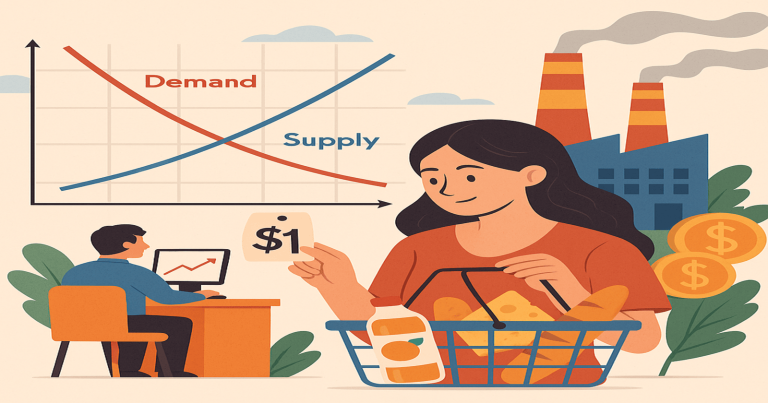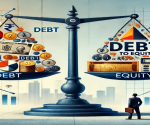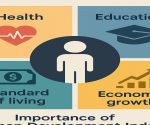Microeconomics looks closely at how individuals, businesses, and industries make everyday economic decisions. It deals with things we often take for granted—why a product becomes more expensive, how companies decide what to produce, or what makes customers change their buying habits. Rather than focusing on the entire economy, microeconomics zooms in on the smaller parts that keep it running. Microeconomics explains how choices are made when resources are limited. It studies how prices are decided in markets, how much of a product should be produced, and what drives consumers to buy one thing over another. It focuses on individual parts of the economy—like a single business or product—rather than the entire system. By looking at demand, supply, costs, and pricing, microeconomics helps reveal the small decisions that shape the bigger picture of economic activity.
Definition of Microeconomics
Microeconomics can be defined as the study of the economic behavior of individuals, firms, and specific markets. It explains how decisions are made when resources are scarce, how those decisions affect supply and demand, and how prices are determined in individual sectors of the economy.
Microeconomics focuses on:
- Individual demand and consumption
- Business production and cost behavior
- Price setting in different market structures
- Resource allocation and efficiency
In academic terms, microeconomics is concerned with partial analysis (studying a single part of the economy) rather than general or whole analysis like macroeconomics.
For example, when a consumer chooses between two mobile phones based on price and features, or when a company decides how many workers to hire, microeconomics explains the reasoning behind those decisions.
Key Concepts in Microeconomics
The key concepts of microeconomics include the most important ideas that explain how small parts of the economy work—like individual buyers, sellers, and businesses. Under this topic, you will learn about how demand and supply decide prices, what elasticity means and how it shows reactions to changes in prices or income, how consumers make choices using utility, how firms decide what and how much to produce, how costs behave, and how different types of market structures (like monopoly or competition) affect business decisions. It also covers how wages, rent, and profits are decided in factor markets.
1. Demand and Supply
These are the most fundamental concepts.
- Demand refers to the quantity of a good or service a consumer is willing and able to buy at different prices during a specific period.
- Supply refers to how much of a good or service a producer is willing and able to sell at various prices.
The interaction of demand and supply determines the equilibrium price, where the quantity demanded equals the quantity supplied.
Real-life Example: When onion supply falls due to bad weather, the price rises. This is a supply shortage, and microeconomics explains this through the supply curve shifting left.
2. Utility and Consumer Behavior
Utility refers to the satisfaction a person gets from consuming a product.
- Total utility is the overall satisfaction from consuming all units.
- Marginal utility is the additional satisfaction from one more unit.
Law of Diminishing Marginal Utility: As consumption increases, each additional unit gives less added satisfaction. This law helps explain why demand curves slope downward.
Example: The first slice of pizza gives more pleasure than the fourth or fifth.
3. Elasticity
Elasticity measures how much one variable changes in response to another.
- Price Elasticity of Demand (PED): How much demand changes when price changes.
- Income Elasticity of Demand (YED): How demand changes with income.
- Cross Elasticity of Demand (XED): How the price of one good affects demand for another.
- Price Elasticity of Supply (PES): How much supply changes with price.
Importance: Elasticity helps businesses decide pricing and helps governments set taxes or subsidies.
4. Opportunity Cost
Opportunity cost is the value of the next best alternative that is given up when a choice is made. It is not always measured in money but in value or benefit.
Example: If a student chooses to study instead of going to a party, the enjoyment from the party is the opportunity cost.
5. Market Structures
Market structures explain how different industries and businesses operate in terms of competition and pricing. They form the backbone of the concept of microeconomics, which studies how individuals and firms make economic decisions. The nature of a market—how many sellers are there, how similar the products are, how easy it is to enter or exit—affects everything from product pricing to consumer choices.
| Market Type | Features |
| Perfect Competition | Many firms, identical products, no control over price |
| Monopoly | One firm dominates, high price control |
| Oligopoly | Few large firms, may collude or compete |
| Monopolistic Competition | Many firms, similar but differentiated products |
Example: Telecom industry in India is an oligopoly with players like Jio, Airtel, and Vi.
Uses of Microeconomics
Microeconomics isn’t only a theory—it’s applied in everyday decision-making, business strategy, and policy-making. Microeconomics is employed by consumers, companies, and governments to study, forecast, and enhance economic performance. From pricing products to assigning resources, from running government budgets to planning investments, microeconomic principles inform shrewd and effective decisions. Here’s how it’s used across sectors:
1. Helps in Price Determination
One of the most important uses of microeconomics is to determine the prices of goods and services in a market. Microeconomics helps in price determination by analyzing how the forces of demand and supply interact in various market structures. It explains how the price of a good or service is set where consumer demand meets producer supply.
- Demand and Supply Analysis: It explains how the interaction of consumer demand and producer supply sets the market price.
- Elasticity: Microeconomics helps understand how price changes affect demand and revenue.
- Example: A mobile company uses price elasticity data to set the right price that balances demand and profit.
2. Aids Business Decision-Making
Firms use microeconomic tools to plan their operations and increase profitability. Microeconomics gives a clear picture of how markets work. It provides tools to predict customer choices, set the right prices, manage costs, and plan investments. Business owners, managers, and startup founders use microeconomic principles to avoid risks and increase profits.
- Cost Analysis: It helps firms calculate fixed and variable costs, break-even points, and profit margins.
- Resource Allocation: Businesses decide how much labor, capital, or material to use based on cost and output.
- Production Decisions: Concepts like marginal cost and marginal revenue help firms determine optimal output levels.
Example: A factory uses microeconomic data to decide whether to expand production or reduce workforce hours.
3. Supports Government Economic Policies
Governments apply microeconomic principles when creating regulations or designing welfare programs. Microeconomics supports government economic policies by providing the necessary tools and data to design effective rules, regulations, and reforms. It helps governments understand how individuals and businesses respond to taxes, subsidies, price controls, and public spending.
- Taxation: Microeconomics predicts how a new tax will affect consumer spending or business profits.
- Subsidies: Helps determine where subsidies will be most effective (e.g., agriculture or healthcare).
- Price Controls: Sets ceilings (maximum price) or floors (minimum wage) to protect consumers or workers.
Example: The government sets minimum support prices for crops based on supply-demand and production cost data.
4. Assists in Studying Consumer Behavior
One of the key uses of microeconomics is that it assists in studying consumer behavior. Microeconomics helps us understand how consumers make choices based on their income, preferences, and the prices of goods. It explains how people try to get maximum satisfaction or utility from limited resources. Concepts like the law of demand, utility theory, indifference curves, and budget constraints give deep insights into buying decisions.
- Utility Theory: Shows how consumers try to get the most satisfaction from limited income.
- Indifference Curves and Budget Lines: Help understand how consumers substitute one good for another when prices change.
- Behavioral Patterns: Supports product marketing strategies by analyzing purchase behavior.
Example: A grocery brand uses consumer choice theory to develop affordable combo packs.
5. Useful in Forecasting Market Trends
Microeconomic models are used to forecast changes in the market based on various factors.Microeconomics is highly useful in forecasting market trends as it studies how demand and supply react to changes in price, income, and consumer preferences. By analyzing historical data and market behavior, microeconomics helps predict future shifts in consumer demand, production levels, and pricing strategies. Tools like demand forecasting, elasticity, and marginal analysis guide businesses and governments in planning for upcoming changes in the market.
- Price Forecasting: Predicts how changes in fuel or raw material prices affect the entire supply chain.
- Demand Estimation: Estimates future demand for a product using trends and elasticity.
- Market Entry/Exit Decisions: Firms use market structure analysis (like monopoly or competition) to decide when to enter or exit a market.
Example: A startup studies market demand and pricing trends before launching a food delivery app.
6. Helps in Understanding Income Distribution
Microeconomics also plays a role in analyzing how income is distributed among individuals and sectors. It examines how wages, profits, rents, and interests are earned and distributed based on factors like skill, education, land ownership, and capital.
- Labor Market Analysis: Explains wage differences between sectors.
- Capital Returns: Studies how profits are divided between owners, investors, and workers.
- Economic Inequality: Provides tools to measure and explain income gaps using marginal productivity and opportunity cost.
Example: Economists use microeconomic indicators to study wage gaps in urban and rural areas.
7. Assists in Resource Allocation
Efficient resource use is at the heart of economics, and microeconomics provides the tools for this.Microeconomics assists in resource allocation by guiding how limited resources like land, labor, capital, and raw materials should be used to get the best possible results. It studies how individuals and firms can allocate these resources efficiently to produce goods and services that are most in demand.
- Marginal Analysis: Firms evaluate the additional benefit of using one more unit of a resource.
- Production Possibility Curve: Shows trade-offs between different choices of resource use.
Example: A textile unit uses marginal cost data to decide whether to produce more cotton or switch to linen.
8. Important for Competitive Strategy
Microeconomics helps businesses assess competition and plan strategy. Microeconomics is important for competitive strategy as it helps firms understand the market structure they operate in and how they can gain an edge over rivals. It analyzes factors like pricing strategies, consumer demand, cost structures, and barriers to entry, which are crucial for making strategic decisions.
- Market Structures: Explains how price and output differ in monopoly, oligopoly, or perfect competition.
- Game Theory: Used in oligopolistic markets to anticipate competitors’ actions.
- Product Differentiation: In monopolistic competition, it shows how branding and quality help gain market share.
Example: Telecom companies use microeconomic analysis to predict rivals’ pricing and decide on offers.
Difference Between Microeconomics and Macroeconomics
Microeconomics and macroeconomics are two principal branches of economic research, each with its own focus, scope, and approach. Although they both address the way economies work, they look at it from different levels and angles. Both are significant, but they concern different levels of economic analysis. Here is a side-by-side comparison:
| Aspect | Microeconomics | Macroeconomics |
| Meaning | Microeconomics is the study of individual economic units such as consumers, firms, households, and specific industries. It focuses on how they make choices with limited resources. | Macroeconomics is the study of the entire economy. It looks at broad aggregates and averages such as national output, inflation, unemployment, and growth. |
| Scope | Concerned with specific markets, pricing of individual goods and services, wage levels in particular sectors, and firm behavior. | Covers the whole economy—national income, GDP, general price level, inflation, interest rates, and employment across all sectors. |
| Focus Area | Analyzes product pricing, cost structure, consumer choice, utility, output decisions, and competition within an industry. | Focuses on fiscal policy, monetary policy, inflation control, GDP growth, national income distribution, and international trade. |
| Key Elements | – Demand and Supply- Utility and Marginal Analysis- Elasticity- Opportunity Cost- Production and Costs- Market Structures | – Aggregate Demand and Aggregate Supply- GDP and GNP- Unemployment- Inflation- Fiscal and Monetary Policies- Business Cycles |
| Objective | To determine price, output, and resource allocation in individual markets. | To stabilize the economy by controlling inflation, boosting employment, and ensuring sustainable growth. |
| Methodology | Uses partial equilibrium analysis—studies one market or sector in isolation, assuming others remain constant. | Uses general equilibrium analysis—examines the interconnection between different sectors and how changes in one affect the whole economy. |
| Market Application | Helps analyze market failure, monopoly behavior, price fixing, and cost efficiency in particular industries. | Helps evaluate national economic performance, plan fiscal budgets, and set interest rates or tax levels for macroeconomic balance. |
| Use in Policy | Used for micro-level policies such as anti-monopoly laws, pricing regulations, consumer protection, and targeted subsidies. | Used for macro-level policies such as inflation targeting, employment generation programs, taxation, and trade regulations. |
| Examples | – How the price of petrol affects daily commuting choices- How a company sets its product price- How labor wages are determined in one industry | – How GDP growth rate affects investment- How inflation impacts consumer spending- How interest rate changes control borrowing and savings |
Microeconomics FAQs
What is microeconomics?
Microeconomics is the study of individual economic units, such as consumers and firms, focusing on decision-making processes and market interactions.
How does microeconomics differ from macroeconomics?
Microeconomics looks at single markets and conduct, whereas macroeconomics looks at the entire economy, such as inflation, unemployment, and economic growth.
What are applications of microeconomics in business?
Microeconomics is applied by businesses for pricing, market research, cost management, and decision-making to maximize profitability and competitive positioning.
Why does microeconomics matter in policy-making?
Microeconomics gives an understanding of consumer conduct, resource allocation, and market efficiency, enabling policymakers to formulate effective economic policies.


